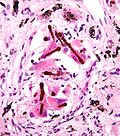Ferruginous body
Ferruginous body refers to a microscopic, rod-like structure often found within the lung tissues, which is coated with iron-containing (ferruginous) material. These bodies are typically associated with the inhalation of certain types of dusts, most notably asbestos fibers, and are considered markers of exposure to these materials. The presence of ferruginous bodies can be indicative of various pulmonary conditions, including asbestosis, chronic obstructive pulmonary disease (COPD), and mesothelioma.
Formation[edit]
Ferruginous bodies form when inhaled fibers, such as asbestos, become coated with a protein-rich material containing iron. This coating process occurs within the lungs and is a response by the body to the presence of foreign materials. The iron coating is thought to be derived from ferritin, an iron-storage protein, which attempts to neutralize the fibers by encapsulating them. However, this process does not render the fibers harmless and instead serves as a marker of exposure.
Health Implications[edit]
The presence of ferruginous bodies in lung tissue is a significant indicator of past exposure to hazardous materials like asbestos. While the bodies themselves are not harmful, their presence suggests that the individual has been exposed to materials that can cause serious lung diseases. Diseases associated with ferruginous bodies include:
- Asbestosis: A lung disease resulting from the inhalation of asbestos particles, leading to lung scarring and breathing difficulties.
- Mesothelioma: A rare form of cancer that affects the lining of the lungs, chest, abdomen, and heart, and is strongly linked to asbestos exposure.
- Lung cancer: Exposure to asbestos and other materials that can lead to the formation of ferruginous bodies is associated with an increased risk of lung cancer.
Diagnosis[edit]
The identification of ferruginous bodies is typically done through histological examination of lung tissue samples obtained via biopsy. Special staining techniques, such as Prussian blue staining, are used to highlight the iron content of the bodies, making them more visible under a microscope.
Prevention and Management[edit]
Preventing exposure to asbestos and other hazardous materials is key to reducing the risk of developing lung diseases associated with ferruginous bodies. This includes adhering to safety guidelines and regulations in workplaces where exposure to such materials is possible. Management of conditions associated with ferruginous bodies involves treating the symptoms and complications of the diseases, as there is no cure for conditions like asbestosis and mesothelioma once they have developed.
See Also[edit]
-
Ferruginous body
-
Asbestosis high magnification
Ad. Transform your life with W8MD's Budget GLP-1 injections from $75


W8MD offers a medical weight loss program to lose weight in Philadelphia. Our physician-supervised medical weight loss provides:
- Weight loss injections in NYC (generic and brand names):
- Zepbound / Mounjaro, Wegovy / Ozempic, Saxenda
- Most insurances accepted or discounted self-pay rates. We will obtain insurance prior authorizations if needed.
- Generic GLP1 weight loss injections from $75 for the starting dose.
- Also offer prescription weight loss medications including Phentermine, Qsymia, Diethylpropion, Contrave etc.
NYC weight loss doctor appointmentsNYC weight loss doctor appointments
Start your NYC weight loss journey today at our NYC medical weight loss and Philadelphia medical weight loss clinics.
- Call 718-946-5500 to lose weight in NYC or for medical weight loss in Philadelphia 215-676-2334.
- Tags:NYC medical weight loss, Philadelphia lose weight Zepbound NYC, Budget GLP1 weight loss injections, Wegovy Philadelphia, Wegovy NYC, Philadelphia medical weight loss, Brookly weight loss and Wegovy NYC
|
WikiMD's Wellness Encyclopedia |
| Let Food Be Thy Medicine Medicine Thy Food - Hippocrates |
Medical Disclaimer: WikiMD is not a substitute for professional medical advice. The information on WikiMD is provided as an information resource only, may be incorrect, outdated or misleading, and is not to be used or relied on for any diagnostic or treatment purposes. Please consult your health care provider before making any healthcare decisions or for guidance about a specific medical condition. WikiMD expressly disclaims responsibility, and shall have no liability, for any damages, loss, injury, or liability whatsoever suffered as a result of your reliance on the information contained in this site. By visiting this site you agree to the foregoing terms and conditions, which may from time to time be changed or supplemented by WikiMD. If you do not agree to the foregoing terms and conditions, you should not enter or use this site. See full disclaimer.
Credits:Most images are courtesy of Wikimedia commons, and templates, categories Wikipedia, licensed under CC BY SA or similar.
Translate this page: - East Asian
中文,
日本,
한국어,
South Asian
हिन्दी,
தமிழ்,
తెలుగు,
Urdu,
ಕನ್ನಡ,
Southeast Asian
Indonesian,
Vietnamese,
Thai,
မြန်မာဘာသာ,
বাংলা
European
español,
Deutsch,
français,
Greek,
português do Brasil,
polski,
română,
русский,
Nederlands,
norsk,
svenska,
suomi,
Italian
Middle Eastern & African
عربى,
Turkish,
Persian,
Hebrew,
Afrikaans,
isiZulu,
Kiswahili,
Other
Bulgarian,
Hungarian,
Czech,
Swedish,
മലയാളം,
मराठी,
ਪੰਜਾਬੀ,
ગુજરાતી,
Portuguese,
Ukrainian


